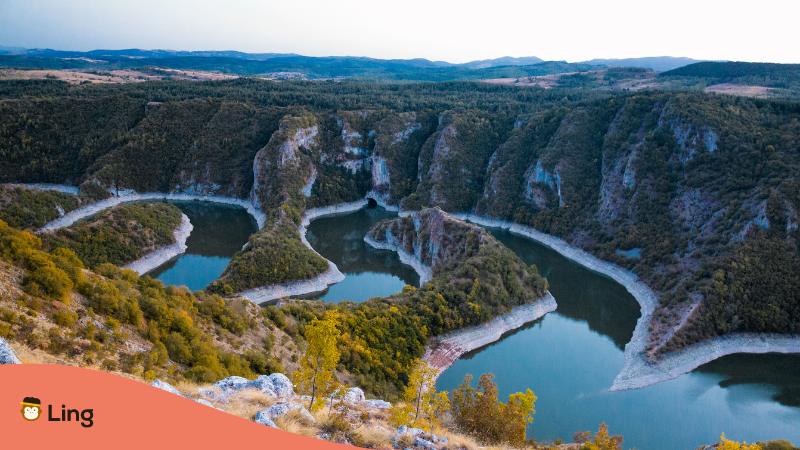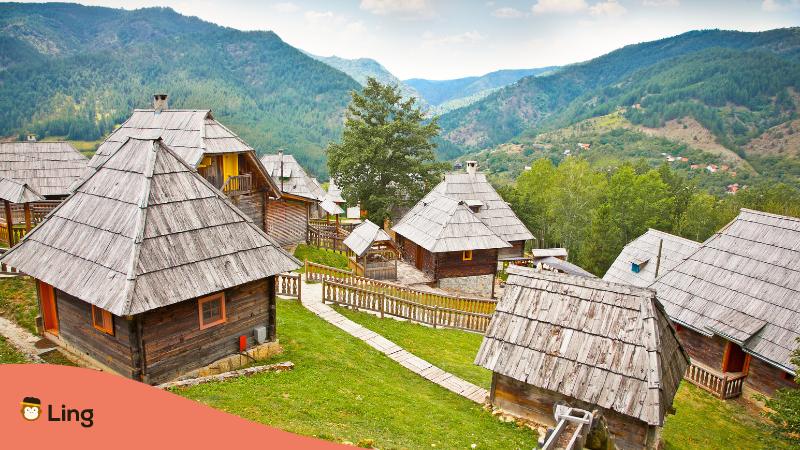Klima u Srbiji (the Serbian climate) is typically continental, with hot summers and cold winters, especially in the north and the mountains. In the country’s south, we have relatively mild winters as we get closer to the Adriatic Sea. The summer months from June to August offer lovely hot weather and just a little rain. The mountains in Serbia experience heavy snowfall in the winter, bringing the ski season, which lasts from November to March.
1. Geografski položaj (Geography)
To the southwest, Serbia borders Montenegro, in the west with Bosnia and Herzegovina, in the northwest with Croatia, and Hungary in the north. Its neighbors to the south are Albania and North Macedonia, while to its southeast is Bulgaria. To the northeast, Serbia borders Romania. Moderate latitude, high mountains, and distance from the sea and ocean significantly affect Serbia’s climate.
Serbia is a land-based state located in the southern part of the Pannonian Plain, where Central and Southeastern Europe meet. The relief is mainly dominated by forests, farms, hills, mountains, rivers, and river valleys. Most of Serbia is covered by mountains that are part of larger mountain ranges, such as the Balkans, the Rhodopes, the Dinaric Alps, and the Carpathians.
The northern part of the country, known as Vojvodina, has rich fields and fertile land that irrigate from the great river Danube. The Morava, a river flowing through the country’s south, meets with limestone mountains, hills, and river basins. The central and western parts of the country are mostly hilly and intersected by rivers and streams, while the limestone terrain is dominant in eastern Serbia.

2. Godišnja doba (Seasons) In Serbia
The Serbian climate can be broken down into four different godišnja doba (seasons), with an average annual temperatura (temperature) ranging from 6.1 ° C (43 ° F) to 11.1 ° C (52 ° F), depending on latitude. Summers are hot, with August being the peak of the summer season.
However, based on my experience, the transition between seasons (spring and autumn) is generally shorter than the main seasons (summer and winter) by about a month. So, leto (summer) and zima (winter) last on average about three and a half months, while proleće (spring) and jesen (autumn) last on average about two and a half months. If we want to compare these two main seasons, it is very easy to conclude that summer is a far more stable season in our country compared to winter. That’s why Klima u Srbiji (Serbian climate) is quite interesting.
During the leto (summer), a wave of extreme heat flows across the country, caused by a warm air current coming from the Sahara. In the north, the winters are quite cold and bring a lot of snow, while the sun in the south is a bit less harsh, thanks to the influence of the Mediterranean. On the other hand, polar air masses in the zima (winter) can also penetrate the ground and cause temperatures to fall far below zero.
Proleće (Spring) is mostly cool with a lot of precipitation, though snow is not unknown for some parts of the country. Jeesen (Autumn) is foggy with a lot of moisture, especially in November, in the west of the country.
May and June are the months in which there is the most rain. The snow cover lasts from November to March, with January bringing the most snowfall. There is more snow in the southern part of the country. As the altitude of the mountains rise, there are more and more days under the snow. So, snow can remain on the slopes of high mountains for up to 120 days a year. Depending on the part of the country we observe, the number of hours of sunshine varies from 1500 to 2000. During late spring and early summer in Serbia, rainstorms are expected. During the winter, in the morning, fog is common.

3. The Best Time To Visit Serbia
The best time to visit Serbia is in the period between May and September. This includes part of proleće (spring), the whole of leto (summer), and the very beginning of jesen (autumn). In addition, the central parts of Serbia, the wider surroundings of Belgrade, can boast very pleasant vremenske uslove (weather conditions) during the month of October.
In the north of the country, early leto (spring) is quite cold and rainy, and it is not impossible to see some snow. In the south of the country, summers are warm with high humidity. Temperature (temperatures) rarely exceed 35 ° C (95 ° F), except for when there are heatwaves.
The Mediterranean mikroklima (microclimate) is what retains the higher temperatures and vlažnost (humidity) in the air in the south. Late proleće (spring) and early jesen (autumn) offer pleasant temperature (temperatures) with plenty of sunny days. June and September are warm enough to be pleasant but suitable for those who want to avoid tropical heat when traveling through Serbia.
4. The Worst Time To Visit Serbia
The worst time to visit Serbia is often considered to be during the zima (winter) period from December to February unless you like to ski. If you don’t like kiša (rain), it is advisable to avoid border months like November and March as well. Winters in the Serbian climate zone can be very harsh, especially in the north of the country or in the mountains over 1000m above sea level. In a short time, temperatures can drop to 0° C (32° F) but often below that value.
Vetrovi (winds) often reach the plains in Serbia and cause serious snowstorms during the winter. The everyday life of the inhabitants of Serbia consists of snow, heavy frost, and thick fog. Daytime is very short during the winter months, and the lack of sun keeps the sky gloomy and dark for a long time during this period. All of this is typical for the Serbian climate.
Learn Serbian with Ling
If you’re eager to visit Serbia, you should learn more about this amazing country, such as Serbian cuisine, through engaging and easy lessons on cool apps such as the Ling App. This application can help you get a hang of the essential Serbian words and phrases. Don’t forget to learn how to say hello in Serbian as well because people will open their hearts more to you when you speak their language. Download the Ling app right now from the App Store or Google Play Store and start your Serbian language learning now!




















